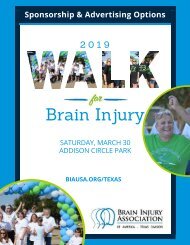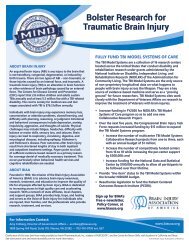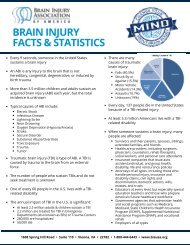THE Challenge! Spring 2011
Communication
Communication
You also want an ePaper? Increase the reach of your titles
YUMPU automatically turns print PDFs into web optimized ePapers that Google loves.
Communication<br />
Strategies<br />
forward. (Coehlo, C.A.; Youse, K.M.; Lee, K.E. 2002). In<br />
addition to initiation and memory problems, disinhibition<br />
and distractibility may result in abrupt topic changes or a<br />
communication partner hastening to end a conversation.<br />
(Ylvisaker, M.; Szekeres, S.; Feeney, T. 2001).<br />
Speech and Emotion: A brain injury can impact the emotion<br />
involved in speaking in several different ways. A person’s<br />
speech may be less clear after an injury. Words may not be<br />
formed as well or volume may be reduced. Speech may also<br />
have less inflection (e.g., variety of pitch or melody line when<br />
talking). This may cause an individual to be self-conscious<br />
about speaking. Also, if there is less inflection in the voice,<br />
an unfamiliar listener may misinterpret the lack of inflection<br />
as meaning disinterest. There are also instances where the<br />
injury can result in the person having decreased ability to<br />
accurately interpret the facial expression or tone of voice of<br />
the communication partner.<br />
Table 1 lists strategies that may be employed<br />
by both the person with a brain injury and the<br />
communication partner to work together to<br />
achieve successful communication interactions.<br />
Cognitive-Communication Strategy List<br />
Problem strategies for speaker strategies for Communication Partner<br />
Reduced Initiation<br />
Disinhibition<br />
Word Retrieval<br />
Losing Train of Thought<br />
Tangential (or unrelated)<br />
Communication<br />
Decreased Memory<br />
Decreased Ability to Read<br />
Non-Verbal Aspects of<br />
Communication<br />
Decreased Ability to<br />
Vary Tone of Voice<br />
Distractibility/<br />
Slowed Processing<br />
1. Decide before your meeting or appointment what<br />
you want to talk about.<br />
2. Encourage the other person to talk about him/herself.<br />
1. Ask yourself before you speak: Do I want this<br />
information to be public?<br />
2. Ask yourself before you speak: Will this information<br />
hurt or embarrass me or anyone else?<br />
1. Focus on the idea, not the words.<br />
2. Try to create an image in your mind and<br />
describe it.<br />
1. Mentally review what you have said and/or restate<br />
the last thing you said.<br />
2. Ask your listener to restate the last thing you said.<br />
1. Accept feedback when someone says they are<br />
having trouble following the conversation.<br />
2. Announce topic shifts.<br />
If you tend to repeat yourself, let your listener know:<br />
“Stop me if I have told you this.” Always asks others:<br />
“How are you?”<br />
Let people who are close to you know you need<br />
them to tell you how they are feeling.<br />
Let people know what you are feeling.<br />
1. Speaking slowly encourages others to do the same.<br />
2. Hold important conversations in quiet rooms.<br />
1. Conversations can be started by the other person.<br />
2. Call attention to areas of interest.<br />
Encourage the person with the brain injury to preview<br />
the message in his or her mind before speaking and<br />
think about the impact on self or others.<br />
1. Encourage the person with brain injury to focus<br />
on the idea not the words.<br />
2. Give the person time to talk.<br />
1. Give the person time to mentally review what<br />
was said.<br />
2. Ask if you should restate the last thing said.<br />
1. Let the person know you are having difficulty<br />
following the conversation.<br />
2. Request clarification on the topic or the basis<br />
for the change.<br />
Consider cueing the person, for example:<br />
“Do you want to know how my interview went?”<br />
Tell the person how you are feeling.<br />
Ask the person how he/she is feeling.<br />
1. Call the person by name and give him/her time<br />
to look at you before you start to speak.<br />
2. Speak at a slightly reduced rate of speech.<br />
(Continued on pg. 5)<br />
<strong>THE</strong> <strong>Challenge</strong>! | <strong>Spring</strong> <strong>2011</strong><br />
4


















